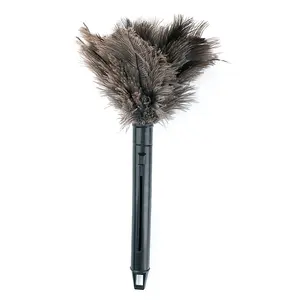
Wholesale Retractable Ostrich Feather Duster With Plastic Handle For Car Cleaning Duster Household Duster















Understanding the world of car dusters can be a complex task as there are a myriad of options available on the market today. Some are portable, some are corded, some are cordless, and some are specifically designed for different cleaning tasks. This guide aims to provide a detailed overview of the various types of car dusters, their features, and the materials they are made of.
Car dusters can be broadly categorized into several types primarily based on their design and functionality. At a basic level, there are cordless dusters and corded dusters. Cordless dusters, often run on battery power, are highly portable and are ideal for quick clean-ups. On the other hand, corded dusters are typically more powerful and are capable of tackling more significant amounts of dust.
Another popular type of car duster is the car duster brush. These are designed to fit into various nooks and crannies of a vehicle, making them a versatile tool for car owners. Air dusters, also known as electric air dusters, are another common type of car duster. These use compressed air to blow away dust and debris, and are particularly effective for electronic components, such as keyboards, where a traditional duster might not be suitable.
The features of a car duster vary widely, depending on the type and intended use. For instance, cordless dusters are often lightweight and compact, making them easy to store and use. They may also feature a variety of attachments or interchangeable heads to tackle different cleaning tasks. On the other hand, corded dusters might offer more power and a longer lifespan, making them a good option for those who frequently use their duster. Electric air dusters tend to be more specialized and may come with additional features, such as adjustable airflow and the ability to blow both hot and cold air. This makes them particularly useful for electronics, where dust can build up and cause overheating or damage. In contrast, a hand duster or duster brush may be simpler in design but can be highly effective for general dusting tasks, particularly when paired with a suitable cleaning solution.
The materials used in the construction of car dusters also vary. Many dusters, particularly those designed for general dusting, are made from microfiber. Microfiber dusters are highly effective at trapping dust and can be easily cleaned and reused. Some dusters may also feature a microfiber head combined with a longer handle, often referred to as a long handled duster, which can be useful for reaching difficult-to-access areas. For more specialized tasks, such as cleaning electronics, an electric duster might be made from hard plastic to withstand the high pressure of the compressed air it uses. Likewise, the bristles of a car duster brush can also be made from a variety of materials, including natural fibers and synthetic materials, each with their own benefits and drawbacks.
Understanding the different types of car dusters, their features, and the materials they are made from can help individuals choose the right tool for their cleaning needs. Whether it's a cordless duster for quick clean-ups, an electric air duster for electronics, or a simple duster brush for general dusting, there's a car duster out there to suit every need.